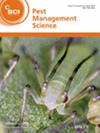求助PDF
{"title":"RNAi of nuclear receptor E78 inhibits the cuticle formation in the molting process of spider mite, Tetranychus urticae.","authors":"Zhuo Li,Qingyan Li,Qixiang Peng,Guy Smagghe,Gang Li","doi":"10.1002/ps.8484","DOIUrl":null,"url":null,"abstract":"BACKGROUND\r\nThe two-spotted spider mite, Tetranychus urticae, is an important pest mite in agriculture worldwide. E78, as a member of the nuclear receptor superfamily and a downstream responsive gene of ecdysteroids, plays a crucial role in regulating physiological behaviors such as development and reproduction in insects. However, its function in mites remains unclear. The aim of this study was to explore how E78 functions in the molting process of spider mites.\r\n\r\nRESULTS\r\nIn this study, reverse transcription quantitative polymerase chain reaction (RT-qPCR) experiments to analyze the expression pattern of TuE78 during the development of Tetranychus urticae, demonstrated that the expression level of TuE78 was higher during the molting state than that after the completion of molting, and it reached a peak expression level when the deutonymph mites entered the molting stage. RNA interference (RNAi)-mediated gene-silencing of TuE78 resulted in 95% deutonymph mite molt failure. A series of analysis under a light microscope, and scanning and transmission electron microscopy revealed that RNAi mites died within the exuvium without ecdysis, and that apolysis had started but the new cuticle was thin and the typical cuticular lamellae were absent, indicating blockage of the post-apolysial processes and explaining molt failure. Hence, transcriptome sequencing confirmed that the expression of cuticle protein and lipid metabolism-related genes was significantly affected after TuE78 silencing.\r\n\r\nCONCLUSION\r\nThis study demonstrated that TuE78 participates in the molting process of Tetranychus urticae by regulating the post-apolysial processes with the formation of new cuticle and successful ecdysis. This in turn suggests the potential of TuE78 as a target for pest mite control and provides a theoretical basis for further exploration of the molecular regulatory mechanism of spider mite molting. © 2024 Society of Chemical Industry. Published by John Wiley & Sons Ltd.","PeriodicalId":218,"journal":{"name":"Pest Management Science","volume":"208 1","pages":""},"PeriodicalIF":3.8000,"publicationDate":"2024-10-14","publicationTypes":"Journal Article","fieldsOfStudy":null,"isOpenAccess":false,"openAccessPdf":"","citationCount":"0","resultStr":null,"platform":"Semanticscholar","paperid":null,"PeriodicalName":"Pest Management Science","FirstCategoryId":"97","ListUrlMain":"https://doi.org/10.1002/ps.8484","RegionNum":1,"RegionCategory":"农林科学","ArticlePicture":[],"TitleCN":null,"AbstractTextCN":null,"PMCID":null,"EPubDate":"","PubModel":"","JCR":"Q1","JCRName":"AGRONOMY","Score":null,"Total":0}
引用次数: 0
引用
批量引用
核受体 E78 的 RNAi 可抑制蜘蛛螨蜕皮过程中角质层的形成。
背景二斑蜘蛛螨(Tetranychus urticae)是全球农业中的一种重要害螨。E78 是核受体超家族的成员,也是蜕皮激素的下游反应基因,在调节昆虫的发育和繁殖等生理行为方面起着至关重要的作用。然而,它在螨类中的功能仍不清楚。结果 在本研究中,通过反转录定量聚合酶链反应(RT-qPCR)实验分析了TuE78在Tetranychus urticae发育过程中的表达模式,结果表明TuE78在蜕皮状态下的表达水平高于蜕皮完成后的表达水平,并且在脱绒螨进入蜕皮阶段时达到表达峰值。通过 RNA 干扰(RNAi)介导的 TuE78 基因沉默导致 95% 的雌螨蜕皮失败。在光学显微镜、扫描和透射电子显微镜下进行的一系列分析表明,RNAi螨在蜕皮过程中死亡,没有蜕皮,蜕皮已经开始,但新的角质层很薄,典型的角质层片缺失,这表明蜕皮后过程受阻,因此蜕皮失败。因此,转录组测序证实,沉默 TuE78 后,角质层蛋白和脂质代谢相关基因的表达受到显著影响。这反过来表明 TuE78 有可能成为害螨控制的靶标,并为进一步探索蜘蛛螨蜕皮的分子调控机制提供了理论基础。© 2024 化学工业协会。John Wiley & Sons Ltd.出版。
本文章由计算机程序翻译,如有差异,请以英文原文为准。


